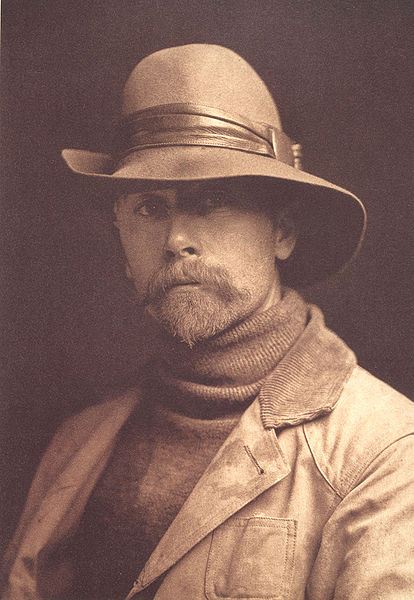Edward S. Curtis
Although unknown for many years, Edward S. Curtis is today one of the most well-recognized and celebrated photographers of Native people. Born near White Water, Wisconsin, on February 16, 1868, he became interested in the emerging art of photography when he was quite young, building his first camera when he was still an adolescent. In Seattle, where his family moved in 1887, he acquired part interest in a portrait photography studio and soon became sole owner of the successful business, renaming it Edward S. Curtis Photographer and Photoengraver.In the mid 1890s, Curtis began photographing local Puget Sound Native Americans digging for clams and mussels on the tide flats. One of his earliest models was Princess Angeline, the aged daughter of Sealth, the Suquamish chief after whom Seattle was named. Later, as an official photographer of the 1899 Harriman Expedition, Curtis documented the geological features of the Alaskan wilderness as well as its indigenous population. This was a pivotal experience for Curtis and greatly increased his interest in Native cultures. He visited tribal communities in Montana and Arizona and began in earnest to photograph many other Native Americans in the West, spending more time in the field and less time in his studio.

The North American Indian Project
In the early years of the 20th century, Curtis embarked on a thirty-year mission which he described as an effort "to form a comprehensive and permanent record of all the important tribes of the United States and Alaska that still retain to a considerable degree their...customs and traditions." Along with most scholars of this period, he believed that indigenous communities would inevitably be absorbed into white society, losing their unique cultural identities. He wanted to create a scholarly and artistic work that would document the ceremonies, beliefs, customs, daily life, and leaders of these groups before they "vanished." The North American Indian project, Curtis decided, would be a set of 20 volumes of ethnographic text illustrated with high quality photoengravings taken from his glass plate negatives. Each of these volumes would be accompanied by a portfolio of large size photogravures, elegantly bound in leather and printed on the highest quality paper. To fund the enormous project, Curtis would sell subscriptions to five hundred sets of the publication.
Working alone or with various assistants, soliciting donations and support from diverse sources including President Theodore Roosevelt and the railroad tycoon John Pierpont Morgan, and also accumulating a heavy personal debt, Curtis visited more than eighty tribes across the country, and north into Alaska and parts of Canada. Eventually, he took more than 40,000 photographs; made over 10,000 recordings of Native speech and music; produced lectures, slide shows, and a multi-media Curtis Indian Picture Opera throughout the U.S.; and in 1914 directed In the Land of the Headhunters, an inventive, seminal film documentary on the Kwakiutl tribe.
Volume one of The North American Indian appeared in 1907. In 1930 the last two volumes were finally published, completing nearly thirty years of work. Only 272 complete sets had been printed. By this time, the modest popularity of Curtis's work had diminished and the North American Indian Corporation--the business enterprise overseeing Curtis's ethnographic ventures--soon liquidated its assets. The original glass plate negatives--most of which had been stored and nearly forgotten in a basement of New York's Morgan Library--were unwittingly dispersed during World War II. Many others were destroyed and some were sold as junk.
When Curtis died in 1952, his lifework with Native Americans had all but faded into obscurity. "Rediscovered" in the 1960s and 1970s, Curtis's photographic work is now recognized as one of the most significant records of Native culture ever produced. His photographs have been included in virtually every anthology of historical photographs of Native Americans and are now frequently used to illustrate books and documentaries.
Mohave Indians